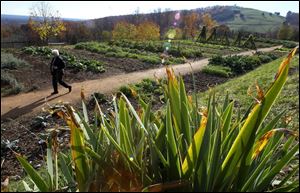
Lessons from Jefferson's organic garden
10/26/2010
Thomas Jefferson grew 330 varieties of vegetables at Monticello.
Vegetable gardeners have discovered it's not necessary to arm yourself with an arsenal of chemicals to grow great produce. As many of us have realized, we need to be more environmentally conscious both inside and outside our homes.
Gardens are living systems. A healthy garden starts from the ground up. In our quest to find examples of eco-friendly gardens around the country for my PBS show, Growing a Greener World, we featured the garden of one of America's most famous organic gardeners, Thomas Jefferson.
Monticello is on a mountaintop, just outside Charlottesville, Va. Jefferson's 5,000-acre plantation served not only as his food supply, but also as a living laboratory. Jefferson grew plants from all over the world, including interesting vegetables such as sea kale, cardoon, Caracalla beans, Florence fennel, fava beans, and crowder peas.
While we can learn many lessons from Jefferson's gardening techniques, a central principle involves regularly adding organic matter for soil health and fertility. Think of soil rich in organic matter as a savings account for your plants. The nutrients you deposit are released back to your plants much like a steady income. Regular additions are necessary to meet the demand. Nutrients found in organic matter stay in the soil longer than water-soluble synthetics, which rapidly leach well beyond the root zone.
Jefferson was one of the first to make the connection between healthy soil and healthy plants. Monticello's kitchen garden is legendary for the variety and scope of its vegetable production. Jefferson's garden was situated on a sunny southern slope. He took meticulous notes about everything, including when he sowed his crops and when they were harvested. He noted crop conditions, observed pests and diseases, and recorded how he solved problems. Jefferson had many failures, but this did not deter him from continuing to work in his beloved garden.
Jefferson was willing to experiment. While he grew 330 varieties of vegetables and 170 varieties of fruit, they weren't all successes. Jefferson was not afraid of failure. He believed that if one thing failed, it is replaced by the success of another. In fact, he embraced every failure as a learning opportunity — something we modernday gardeners should appreciate as well.
Jefferson believed in adding soil-building components such as compost, manure, and decomposing leaves to his soil because he noticed that the plants flourished in that environment, suffered from fewer pests and diseases, and were more drought resistant. Today we know that organic matter promotes healthy biological activity within the soil, a complex web of life ranging from microbes to earthworms.
We can learn a lot about organic gardening from various resources: the Web, an organic garden gardening club, a lecture or your gardening neighbor. Jefferson has educated us on a variety of techniques still used today. But it all begins with healthy soil and a positive can-do attitude. In spite of many challenges,
Jefferson showed us that while some of our gardening endeavors may fail, others would fl ourish — as long as we persevered and learned every step of the way. That's a great philosophy we can all use in our everyday lives.
Kelly Heidbreder's column will return next Wednesday.